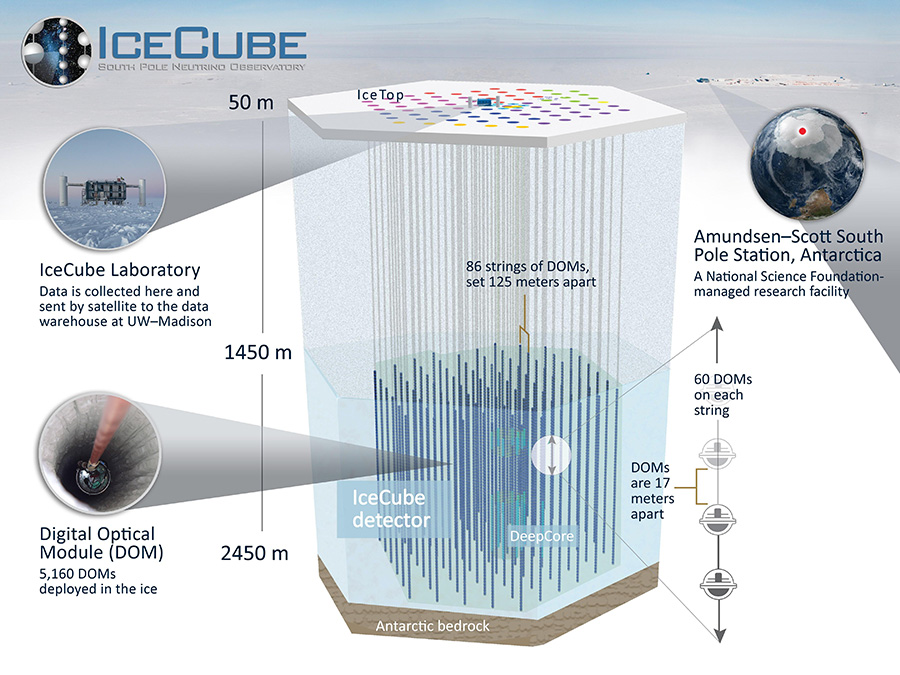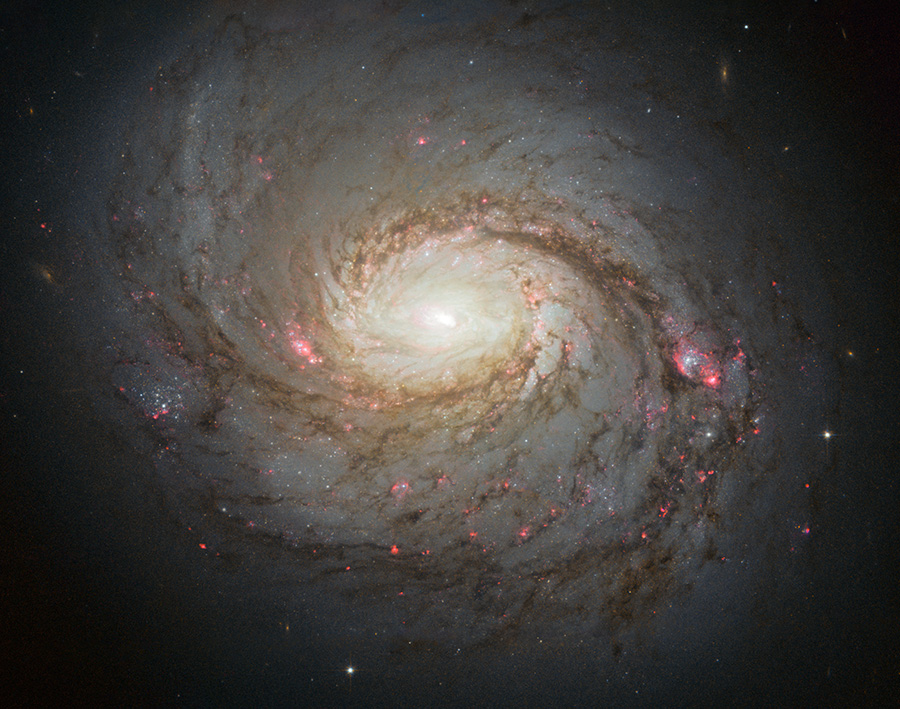Ghost particles give scientists first look inside an active galaxyA decade's worth of neutrino detections at the South Pole offers a new way to peer deeply into a powerful cosmic acceleratorJanuary 30, 2023
The IceCube Neutrino Observatory has detected about 80 high-energy neutrinos emitted by a single active galaxy over the course of ten years, a finding that gives astrophysicists new clues about the violent and chaotic environments surrounding supermassive black holes. 
Image Credit: IceCube/NSF.
The IceCube Neutrino Observatory instruments a volume of roughly one cubic kilometer of clear Antarctic ice at the South Pole. Over 5,000 digital optical modules (DOMs) are frozen at depths between 1,450 and 2,450 meters.
IceCube has detected over 500,000 neutrinos since its first full science run in 2011, but most of those particles were created in our own atmosphere. Those atmospheric neutrinos create a background “noise” that scientists must sort through to identify neutrinos that originated elsewhere. Researchers report in a new study that about 80 neutrinos detected by IceCube came from a single spot in the sky: the nearby galaxy NGC 1068, also known as Messier 77. The results show NGC 1068 acts as a powerful cosmic particle accelerator, speeding up elementary particles like protons to extreme energies. This is the second time IceCube has identified a specific galaxy as a neutrino factory, and NGC 1068 is only the second known high-energy neutrino producer outside our planet. The findings help scientists better understand the violent particle collisions that produce neutrinos in active galaxies, where supermassive black holes rule supreme. “This is the first clue, the first direct observation, of where protons are born and accelerated,” said Francis Halzen, a physicist at the University of Wisconsin - Madison and principal investigator of IceCube. “It's kind of a dream come true: Now we know where the acceleration happens.” Signals from a galaxy's dark heartNeutrinos, nearly massless particles that pervade space, rarely interact with normal matter. The ghostly particles haunt the universe, traveling at nearly the speed of light, passing effortlessly through matter, and carrying information about whence they came. The first trick is catching them: an extremely small fraction of neutrinos will strike an atomic nucleus and create a detectable signal. The second trick is figuring out where they came from. 
Photo Credit: Jack Pairin, IceCube/NSF.
The location of galaxy NGC 1068 in relation to the Cetus constellation (also known as 'the whale'.)
IceCube is the world's largest neutrino detector. It's a massive telescope comprised of more than 5,000 sensors buried in a cubic kilometer of clear ice at Amundsen-Scott South Pole Station. IceCube scientists use Cherenkov radiation — like a sonic boom but with light instead of sound — to determine the direction from which a neutrino came. That direction becomes a point in a map of the sky. “If you have enough points in the sky, you can begin to look at the neutrino sky,” Halzen said. “Then we look after 10 years where, in some places, a source sticks out.” In the new study, scientists looked at cosmic neutrinos IceCube detected from 2011 to 2020. They cross-referenced the direction each neutrino came from with the locations of 110 galaxies known to produce high-energy gamma rays. Gamma rays are the highest-energy light particles in the universe and are produced alongside neutrinos in cosmic accelerators. The results helped researchers identify the hottest point seen so far in the neutrino sky: the galaxy NGC 1068. NGC 1068 is one of the most well-studied galaxies. Located about 47 million light-years away in the constellation Cetus ("the whale"), it's visible with large binoculars. The core of NGC 1068, called an active galactic nucleus, is a supermassive black hole millions of times more massive than our sun. The findings show scientists can use neutrinos as tools to look at the innermost part of the galaxy, behind the thick veil of dust surrounding the supermassive black hole at its center. That cloud of dust prevents astronomers from directly observing the black hole with optical telescopes. The work required input from hundreds of collaborators. Some, like Halzen, had worked on the project since the beginning, but many were graduate students and postdocs who were new to the project. “It's very nice to see science in action through the generations of people that contributed,” said Elisa Resconi, a physicist at the Technical University of Munich in Germany and a lead author of the study. Deciphering the neutrino messageThe findings show physicists that neutrinos are coming from NGC 1068, but where and how neutrinos are made inside the galaxy is still a mystery. 
Image Credit: Moreno Baricevic, IceCube/NSF.
The IceCube Lab at the South Pole houses the computers that collect data from the sensors under the ice.
“The question is, 'Where are these particles boosted up to amazing energies?'” Resconi said. One way to make neutrinos is to accelerate protons to very high energies. Those protons crash into each other and produce neutrinos and gamma rays, which would blaze away from the galaxy's core. The new study shows NGC 1068 wasn't producing gamma rays at the same rate at which it was spitting out neutrinos. This could mean neutrinos are being made extremely close to the black hole, where surrounding matter and radiation is so dense that gamma rays cannot escape — most of them interact with matter and get destroyed as they travel. Since neutrinos rarely interact with anything, they were able to escape. The researchers must now piece together these clues about the cosmic accelerator inside NGC 1068. “With that extra piece of not seeing gamma rays from [NGC 1068], the picture that is coming together is neutrino production near the supermassive black hole and particle acceleration there,” said Hans Niederhausen, a postdoctoral associate at Michigan State University and one of the main analysts for the study. Being able to probe an active galaxy with neutrino messengers could usher in a new frontier in particle physics, according to the study authors. “There is outside the Earth a laboratory that is a galaxy, and now we are accessing that laboratory,” Resconi said. IceCube is operated by the University of Wisconsin-Madison and supported by the National Science Foundation (Award No. 2042807, Award No. 1913607), which manages the U.S. Antarctic Program. |
"News about the USAP, the Ice, and the People"



For USAP Participants |
For The Public |
For Researchers and EducatorsContact UsU.S. National Science FoundationOffice of Polar Programs Geosciences Directorate 2415 Eisenhower Avenue, Suite W7100 Alexandria, VA 22314 Sign up for the NSF Office of Polar Programs newsletter and events. Feedback Form |


